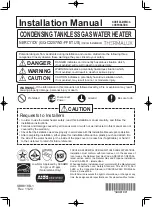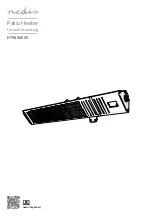
7
Properly maintained, your water heater will provide years of depend-
able trouble-free service. It is suggested that a routine preventive
maintenance program be established and followed by the user. It is
further recommended that a periodic inspection of the operating con-
trols, heating element and wiring should be made by service person-
nel qualified in electric appliance repair.
1. ROUTINE PREVENTATIVE MAINTENANCE
A.
Most electrical appliances make some sound when in operation,
even when new. If the hissing or singing sound level increases ex-
cessively, the electric heating element may require cleaning. Con-
tact your installer or plumbing contractor to inspect.
B.
The area near the water heater must be kept free of flammable liq-
uids such as gasoline or paint thinners, adhesives or other com-
bustible materials.
C.
At least once a year, lift and release the lever handle on the tem-
perature pressure relief valve, located near the top of the water
heater, to make certain the valve operates freely and allow sever-
al gallons to flush through discharge line. Make certain the dis-
charged water is directed to an open drain.
Before manually operating the relief valve, make certain no one will be
exposed to the danger of coming in contact with the hot water re-
leased by this valve. The water may be hot enough to create a SCALD
hazard. The water released should be directed to a suitable drain to pre-
vent injury or damage.
NOTE: If the temperature and pressure relief valve on the water heater
discharges periodically, this may be due to thermal expansion in a
“Closed” water system. Contact the water supplier or your plumb-
ing contractor on how to correct this. DO NOT plug the relief valve out-
let.
D.
A water heater’s tank can act as a settling basin for solids sus-
pended in the water. It is, therefore, not uncommon for hard water
deposits to accumulate in the bottom of the tank. It is suggested that
a few quarts of water be drained from the water heater’s tank every
month to clean the tank of these deposits.
E.
Rapid closing of faucets or solenoid valves in automatic water
using appliances can cause a pounding “water hammer” sound.
“Water hammer” can be described as a banging noise heard in a
water pipe following an abrupt alteration of the flow with resulting
pressure surges. Strategically located risers in the water pipe sys-
tem can be used to minimize the problem. Also water hammer ar-
resting devices are usually available from your plumber or local
plumbing supply store.
2. ANODE ROD INSPECTION —
The anode rod should be removed
from the water heater’s tank annually for inspection and replaced
when more than 6” of core wire is exposed at either end of the rod.
Refer to Fig. 2 for anode rod location. Make certain cold water sup-
ply is turned off before removing anode rod.
The thermostat protective cover SHOULD NOT be removed
.
(Refer to Fig. 4.) Press red “RESET” button. Replace insulation
and jacket access panel before turning on power to water heater.
3. EMERGENCY INSTRUCTIONS —
If water heater has been subjected to flood, fire, or physical damage,
turn off power and water to water heater. Do not operate the water
heater again until it has been thoroughly checked by qualified service
personnel. In cases of flood or fire, the manufacture recommends re-
placement.
4. VACATION AND LONG TIME SHUT-DOWN —
If the water heater
is to remain idle for an extended period of time, the power and
water to the water heater should be turned off to conserve ener-
gy. The water heater and piping should be drained if they might
be subjected to freezing temperatures.
NOTE: Refer to “Hydrogen Gas Caution” in Safety Precau-
tions Section on page 6.
After a very long shut-down period, the water heater’s operation
and controls should be checked by qualified service personnel.
Make certain the water heater is completely filled before again
placing it in operation .
5. DRAINING HEATER —
Shut off power to water heater before draining water.
In order to drain water heater, turn off cold water supply, then it
is necessary to open a hot water faucet or lift the handle on the
relief valve to admit air to the tank. Attach a garden hose to the
drain valve on the water heater and direct the stream of water to
a drain where it will do no damage.
The water drained from the tank may be hot enough to present a SCALD
HAZARD and should be directed to a suitable drain to prevent injury or
damage.
6. ANODE —
This water heater is equipped with an anode rod de-
signed to prolong the life of the glass lined tank. The anode is
slowly consumed cathodically, thereby eliminating or minimiz-
ing corrosion of the glass lined tank.
Water sometimes contains a high sulfate and/or mineral content
and together with the cathodic protection process can produce
a hydrogen sulfide or rotten egg odor in the heated water. Chlo-
rination of the water supply should minimize the problem.
NOTE: Do not remove the anode rod from the water heater’s
tank, except for inspection and/or replacement, as operation
with the anode rod removed will greatly shorten the life of
the glass lined tank and will exclude warranty coverage.
Operation
Maintenance
DANGER
!
CAUTION
!
WARNING
!
DANGER
!


































